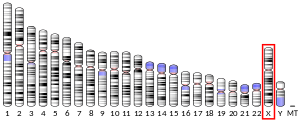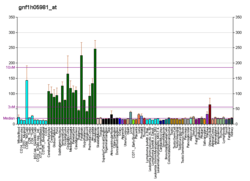PDZD4
PDZ domain-containing protein 4 is a protein that in humans is encoded by the PDZD4 gene.[5][6][7]
| PDZD4 | |||||||||||||||||||||||||
|---|---|---|---|---|---|---|---|---|---|---|---|---|---|---|---|---|---|---|---|---|---|---|---|---|---|
| Identifiers | |||||||||||||||||||||||||
| Aliases | PDZD4, LU1, PDZK4, PDZRN4L, PDZ domain containing 4, LNX5 | ||||||||||||||||||||||||
| External IDs | OMIM: 300634 MGI: 2443483 HomoloGene: 13046 GeneCards: PDZD4 | ||||||||||||||||||||||||
| |||||||||||||||||||||||||
| |||||||||||||||||||||||||
| |||||||||||||||||||||||||
| |||||||||||||||||||||||||
| Orthologs | |||||||||||||||||||||||||
| Species | Human | Mouse | |||||||||||||||||||||||
| Entrez | |||||||||||||||||||||||||
| Ensembl | |||||||||||||||||||||||||
| UniProt | |||||||||||||||||||||||||
| RefSeq (mRNA) |
| ||||||||||||||||||||||||
| RefSeq (protein) |
| ||||||||||||||||||||||||
| Location (UCSC) | Chr X: 153.8 – 153.83 Mb | Chr X: 73.79 – 73.82 Mb | |||||||||||||||||||||||
| PubMed search | [3] | [4] | |||||||||||||||||||||||
| Wikidata | |||||||||||||||||||||||||
| |||||||||||||||||||||||||
References
- GRCh38: Ensembl release 89: ENSG00000067840 - Ensembl, May 2017
- GRCm38: Ensembl release 89: ENSMUSG00000002006 - Ensembl, May 2017
- "Human PubMed Reference:". National Center for Biotechnology Information, U.S. National Library of Medicine.
- "Mouse PubMed Reference:". National Center for Biotechnology Information, U.S. National Library of Medicine.
- Nagase T, Kikuno R, Ishikawa K, Hirosawa M, Ohara O (Sep 2000). "Prediction of the coding sequences of unidentified human genes. XVII. The complete sequences of 100 new cDNA clones from brain which code for large proteins in vitro". DNA Res. 7 (2): 143–50. doi:10.1093/dnares/7.2.143. PMID 10819331.
- Nagayama S, Iiizumi M, Katagiri T, Toguchida J, Nakamura Y (Jul 2004). "Identification of PDZK4, a novel human gene with PDZ domains, that is upregulated in synovial sarcomas". Oncogene. 23 (32): 5551–7. doi:10.1038/sj.onc.1207710. PMID 15077175.
- "Entrez Gene: PDZD4 PDZ domain containing 4".
Further reading
- Gerhard DS, Wagner L, Feingold EA, et al. (2004). "The status, quality, and expansion of the NIH full-length cDNA project: the Mammalian Gene Collection (MGC)". Genome Res. 14 (10B): 2121–7. doi:10.1101/gr.2596504. PMC 528928. PMID 15489334.
- Katoh M, Katoh M (2004). "Identification and characterization of human PDZRN4L gene and mouse Pdzrn4l gene in silico". Int. J. Mol. Med. 13 (6): 923–7. doi:10.3892/ijmm.13.6.923. PMID 15138636.
- Ota T, Suzuki Y, Nishikawa T, et al. (2004). "Complete sequencing and characterization of 21,243 full-length human cDNAs". Nat. Genet. 36 (1): 40–5. doi:10.1038/ng1285. PMID 14702039.
- Strausberg RL, Feingold EA, Grouse LH, et al. (2003). "Generation and initial analysis of more than 15,000 full-length human and mouse cDNA sequences". Proc. Natl. Acad. Sci. U.S.A. 99 (26): 16899–903. doi:10.1073/pnas.242603899. PMC 139241. PMID 12477932.
- Brenner V, Nyakatura G, Rosenthal A, Platzer M (1997). "Genomic organization of two novel genes on human Xq28: compact head to head arrangement of IDH gamma and TRAP delta is conserved in rat and mouse". Genomics. 44 (1): 8–14. doi:10.1006/geno.1997.4822. PMID 9286695.
- Sandoval N, Bauer D, Brenner V, et al. (1996). "The genomic organization of a human creatine transporter (CRTR) gene located in Xq28". Genomics. 35 (2): 383–5. doi:10.1006/geno.1996.0373. PMID 8661155.
This article is issued from Wikipedia. The text is licensed under Creative Commons - Attribution - Sharealike. Additional terms may apply for the media files.




